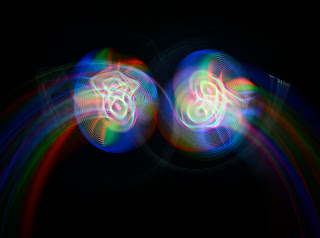 |
January/February 2012
|
|
|
Camera tossing is really about having a good warranty or a healthy trust fund. But I'm guessing the retail store that you bought that point 'n shoot from is going to change their policy soon if you keep exchanging that crumpled piece of plastic and flexible cables for a new model. Seriously though, I haven't broken my camera yet (knock on, well okay - fiberboard) so I keep doing it. More on the risks and joys of letting go
here.
Now that you are on board you want to know what the best targets are for getting something more than a wobbly smear onto the sensor. First, you can always look for targets in the wild like neon signs or other tasty light sources (multicolor neon signs, fake neon signs, or signs that look like neon). Tossing outdoors is much riskier so I prefer pictures of neon signs that I can load up onto the monitor at home complete with a cushy landing pad for my expensive electronics to rest on if by chance I fail to make a good catch. While neon is my obvious choice and a great target, once you've set up your monitor that opens up other possibilities. You can use drawing programs to create shapes and toss against those. You can use another's image if you get permission or if it is CC (Creative Commons) licensed - but it is good etiquette to get permission anyway. Note that the license must NOT include the NoDerivs term. Avoid licenses with this symbol:
 |
| CC NoDerivs license |
Tossing at different types of monitors will create different results. If you have a CRT - a monitor that refreshes, you will obtain combined "snapshots" of the display in a pattern that matches the flight of your camera.
The faster the rate, the more snapshots. There are other variables such as speed of spin and shutter open time that will contribute to this number.
Blinking lights will also produce a similar less smooth effect:
Modern displays like LED monitors don't refresh but the brightness can be adjusted to change the image results slightly. These produce smoother images because the sensor is being saturated for the complete duration of the toss. The image used for this month's magazine cover is an example of an LED target set at a medium brightness level. Spikes and Spines below was shot at a brightness set lower and a double "exposure" effect was obtained:
Try all 3 types and if you are adventurous, combine them with a covered lens cap mid exposure to create hybrids. If you come up with another type or technique, leave me a comment!
Happy (and safe) tossing!







No comments:
Post a Comment